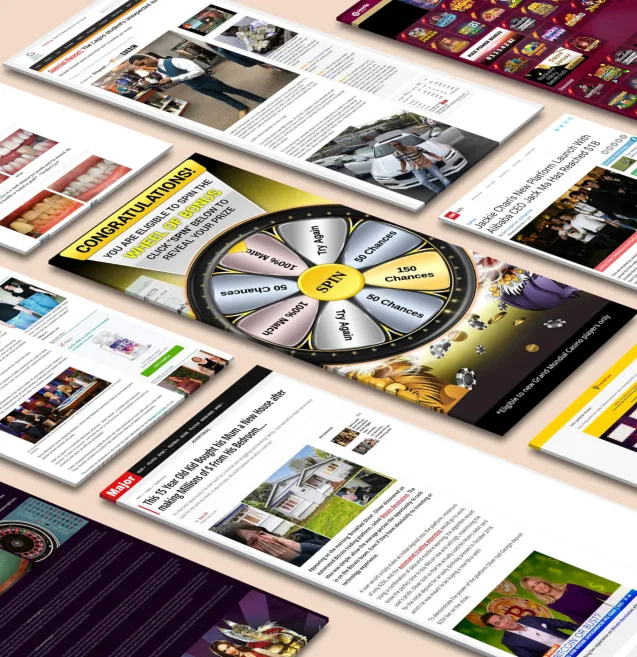
Our spy tools monitor millions of native ads from over 60+ countries and thousands of publishers.
Get StartedNative advertising has transformed digital marketing by seamlessly integrating promotional content into users' natural online experiences. This sophisticated approach to advertising has gained remarkable traction, with U.S. spending projected to reach $30.88 billion by 2023 (source).
The secret to successful native advertising isn't really a secret at all - it's about creating value while maintaining authenticity. Brands that master this balance can achieve exceptional results through:
The challenge lies in delivering promotional messages that feel natural and non-disruptive while maintaining ethical marketing practices. When executed properly, native ads can enhance user experience rather than interrupt it - a stark contrast to traditional advertising methods.
Leading brands have already cracked the code on effective native advertising. From Oreo's creative "Daily Twist" campaign to Archer's clever Reddit promotions, these success stories demonstrate the power of authentic, value-driven content. We'll explore these case studies and uncover the strategies that made them work, providing you with actionable insights to elevate your native advertising efforts.
Native advertising is a sophisticated approach to digital marketing that seamlessly integrates promotional content into users' natural content consumption patterns. These ads match the visual design, function, and behavior of the media format where they appear.
Native advertising takes various forms across digital platforms:
Traditional banner ads interrupt user experience with obvious promotional messaging. Native ads take a different path - they enhance the user journey by providing relevant content that adds value while maintaining the platform's natural flow.
Native Ads Traditional Ads Matches platform design | Stands out from content |
Provides value-first content | Focuses on direct promotion |
Encourages engagement | Pushes for immediate action |
Builds long-term relationships | Aims for quick conversions |
The effectiveness of native advertising stems from its ability to respect user experience while delivering brand messages. When users encounter in-stream ads that align with their interests and browsing patterns, they're more likely to engage meaningfully with the content.
Interactive content within native ads creates opportunities for deeper engagement:
These engaging formats transform passive content consumption into active participation, creating memorable brand experiences that resonate with modern audiences.
Native advertising has experienced explosive growth in recent years, with market projections painting an optimistic future. The Interactive Advertising Bureau (IAB) reports indicate native ad spending will reach $98.59 billion in 2023, a 372% increase from 2020.
Leading media publishers have repositioned their business models to capitalize on native advertising revenue. BuzzFeed generates approximately 60% of its revenue through native content, while The New York Times' T Brand Studio has become a cornerstone of their digital strategy.
Social media platforms have revolutionized native advertising through sophisticated targeting capabilities and seamless content integration. Facebook's in-feed ads generate $84.2 billion in annual revenue, while Instagram's sponsored posts achieve engagement rates up to 4%.
The rise of programmatic native advertising has streamlined campaign management and optimization. Real-time bidding platforms now automate native ad placement across thousands of premium publishers, enabling advertisers to scale their campaigns efficiently while maintaining targeting precision.
These market dynamics have attracted significant investment from both advertisers and publishers, creating a robust ecosystem for native advertising growth. Brands increasingly allocate larger portions of their digital marketing budgets to native formats, recognizing their effectiveness in engaging ad-averse audiences.
Native advertising's rapid growth has sparked intense debate within the digital marketing landscape. At the heart of this controversy lies a critical concern: consumer deception through inadequate source attribution and transparency.
A landmark case highlighting these issues emerged in 2013 when The Atlantic published a sponsored article promoting Scientology. The piece, which mimicked the publication's editorial style, faced immediate backlash from readers who felt misled by its promotional nature. The Atlantic quickly removed the content and issued an apology, but the incident became a cautionary tale about the risks of poorly executed native advertising.
Research by the University of Georgia revealed that 86% of consumers cannot distinguish between native ads and organic content. This statistic prompted regulatory bodies to take action against deceptive practices.
The Federal Trade Commission (FTC) responded by implementing strict guidelines for native advertising:
BuzzFeed faced similar criticism when readers discovered that its "10 Life-Changing Beauty Hacks" article was actually a paid promotion for a cosmetics brand. The backlash highlighted how undisclosed native advertising can damage both publisher and brand credibility.
The controversy surrounding native advertising has led to several changes within the industry:
The New York Times addressed these challenges by creating T Brand Studio, establishing clear guidelines for sponsored content that maintains editorial integrity while providing transparent attribution. This approach demonstrates how native advertising can succeed when built on a foundation of honesty and clear disclosure.
Creating successful native advertising requires a strategic approach that balances transparency, engagement, and precise targeting. Let's dive into proven practices that drive results.
The success of native advertising hinges on understanding your audience's needs and delivering value through content that naturally fits their online experience. Brands that excel in native advertising treat their sponsored content as a service to their audience rather than just another advertising channel.
A data-driven approach to content creation and distribution helps identify what resonates with specific audience segments. This information guides future content development and targeting strategies, creating a cycle of continuous improvement in campaign performance.
Remember to monitor engagement metrics and user feedback to refine your approach. Successful native advertising campaigns evolve based on real-time performance data and changing audience preferences.
Let's examine two groundbreaking native advertising campaigns that redefined brand engagement through innovative content strategies.
Oreo's 'Daily Twist' campaign showcased the power of real-time marketing in native advertising. The brand created 100 pieces of custom content over 100 days, each responding to current events and pop culture moments.
Key achievements:
The campaign's success stemmed from its ability to tap into trending conversations while maintaining brand authenticity. A standout moment included an Oreo cookie featuring a rainbow filling in support of Pride Day, which became one of the most shared branded posts of that year.
FX Network's animated series Archer demonstrated masterful understanding of platform-specific content through its Reddit campaign. The show's marketing team created sponsored posts that mimicked genuine Reddit interactions, featuring the show's characters participating in popular subreddit discussions.
Campaign highlights:
The campaign succeeded by embracing Reddit's unique culture and humor, with character accounts participating in AMAs (Ask Me Anything) sessions and contributing to discussions about spy movies, cocktail recipes, and workplace dynamics.
These campaigns exemplify three essential elements of effective native advertising:
These examples demonstrate how brands can create meaningful connections through native advertising by understanding platform dynamics and audience expectations. The campaigns prove that successful native advertising requires a deep understanding of both the medium and the message.
Native advertising success hinges on striking a delicate balance between compelling content and ethical practices. Brands must navigate the fine line between engaging their audience and maintaining transparency in their promotional efforts.
Successful native advertising strategies prioritize consumer autonomy by empowering users to make informed decisions. This approach includes:
Brand communication thrives when companies prioritize long-term relationships over short-term gains. Research shows that 71% of consumers lose trust in brands that prioritize profits over people. This statistic underscores the importance of ethical native advertising practices.
Trust issues emerge when brands blur the lines between editorial and promotional content. Successful native advertising isn't a secret - it's built on transparency and value delivery. Companies can maintain engagement while respecting consumer intelligence by:
"Delivering content that educates, entertains, or solves problems while clearly identifying its commercial nature creates lasting brand relationships."
The most effective native advertising campaigns acknowledge the sophistication of modern consumers. These campaigns recognize that today's audiences appreciate brands that treat them as partners rather than targets. This recognition drives the development of content that serves both commercial and consumer interests without compromising ethical standards.
The future of native advertising is all about creating meaningful connections while staying true to ethical standards. Brands that can find this balance will help shape a digital world where advertising enhances the user experience instead of ruining it.
The evolution of native advertising extends beyond profit margins - it influences how people interact with digital content and shapes their trust in brands. Companies embracing ethical native advertising practices contribute to a healthier digital ecosystem where commercial interests align with consumer well-being.
The secret to good native advertising isn't really a secret at all - it's about creating genuine value while maintaining unwavering transparency. As technology advances and consumer expectations evolve, successful brands will be those who view native advertising as an opportunity to build authentic connections rather than just another marketing channel.
For valuable insights and tools to enhance your native advertising strategy, explore Anstrex Native to discover effective approaches and refine your campaigns.
Ready to dive deeper? Explore resources from the Interactive Advertising Bureau (IAB) and Digital Content Next for comprehensive guides on ethical native advertising practices. Your journey toward creating impactful, responsible native advertising campaigns starts with understanding these fundamental principles.
Receive top converting landing pages in your inbox every week from us.
How-To
Native ads can do more than drive clicks—they can build long-term brand loyalty. Learn how to use authentic storytelling, strategic placement, and audience targeting to strengthen trust during year-end campaigns. Discover how subtle, value-driven messaging keeps customers engaged beyond the holidays. Ideal for marketers aiming to turn seasonal buyers into loyal brand advocates.
Marcus Chen
7 minDec 15, 2025
Must Read
As third-party cookies fade away, contextual targeting is making a powerful comeback. Learn how to leverage native ads that align with user intent and content relevance to maintain high engagement and conversions. Discover modern tools and tactics that make cookie-free targeting both precise and scalable. Ideal for advertisers seeking privacy-friendly ways to drive performance in 2025 and beyond.
Liam O’Connor
7 minDec 9, 2025
Recently Updated
Native ads can make or break your holiday marketing success. Explore how to evaluate your recent campaigns and identify what worked—or what fell short—with native advertising. Learn key optimization tactics to boost engagement, strengthen audience trust, and increase conversions in future promotions. Ideal for marketers aiming to refine their ad strategies after the holiday rush.
Elena Morales
7 minDec 1, 2025




